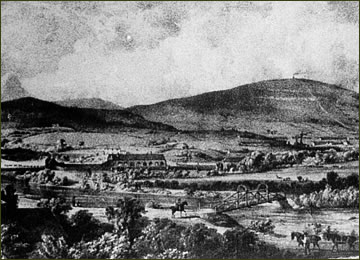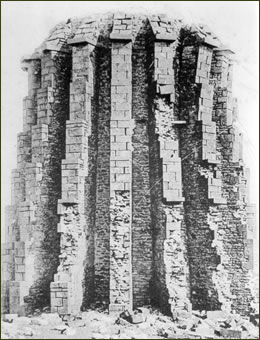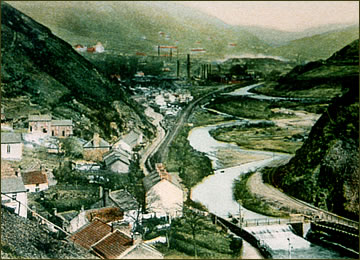
The Cwmafan valley is some three miles long and about a mile at its widest. On either side are steep hills which meet at Pantdu and Pontrhydyfen. During the 18th century before the growth of industry the valley was rural with people living in scattered farms and cottages. Oak forests covered much of the hillsides and in the fertile soils of the valley floor, hay, barley and wheat were grown and sheep and cattle grazed.
 Cwmafan in 1839. The valley was still largely rural but smoke can be seen from the stack on the Foel, also the culvert that carried the fumes up from the copper works.
Cwmafan in 1839. The valley was still largely rural but smoke can be seen from the stack on the Foel, also the culvert that carried the fumes up from the copper works.
In 1801 the population of Cwmafan parish stood at 232, but with the growth of industry people arrived from England, Ireland and many parts of Wales in search of work. Cwmafan quickly grew as a coal, copper and iron and tinplate producing centre and by 1841 the population had risen to over 4000. Large numbers of houses were built for the workers, also schools, a reading room, company shops, chapels and other amenities below the famous Stack y Foel.
 Stack y Foel, said to be one of the wonders of Glamorgan and one of the longest in the world was knocked down in 1940, having been a marker for German bombers in the Second World War.
Stack y Foel, said to be one of the wonders of Glamorgan and one of the longest in the world was knocked down in 1940, having been a marker for German bombers in the Second World War.
Stack y Foel at 13 metres high, stood on the summit of Mynydd Foel. Linked by a tunnel or culvert from the valley below it carried fumes away from the copper works and also the smoke that would damage the health of the workers. Its purpose was to detain the metal particles in the fumes, which were collected from the walls of the culvert and re-used in the works.
However, the fumes poisoned the mountainside and surrounding land, crops, sheep and cattle. On a number of occasions the owners of the works were taken to court by local farmers and Miss Talbot of Margam Park to try to stop the pollution. The cost of imported ores and competition finally led to the works closing.
With the decline of its industries at the turn of the 20th century Cwmafan's copper works and blast furnaces ceased to function, the engineering depot closed and in 1921 the coke ovens closed leaving only the tinplate industry and brick works. Later many of the neat rows of cottages built to house workers were knocked down and new houses built on the slopes of the Foel and on the site of former slag tips.
 The Cwmafan valley in 1904, viewed from Pantdu. The stacks of the various works can be seen, also two railways and the River Afan at Corlannau
The Cwmafan valley in 1904, viewed from Pantdu. The stacks of the various works can be seen, also two railways and the River Afan at Corlannau
Cwmafan is the village that has seen the greatest change in the valley. Once a centre of coal mining, iron and copper smelting and the tinplate industries it is now a thriving suburb of Port Talbot.


